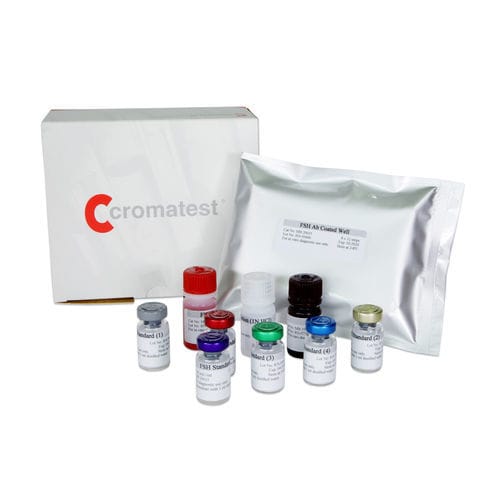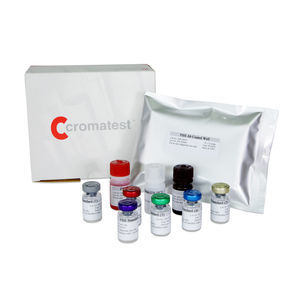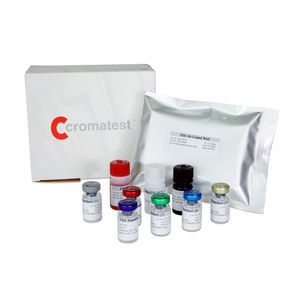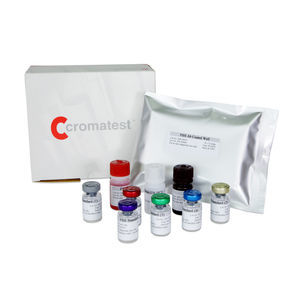
- Laboratory
- Laboratory medicine
- Solution reagent
- LINEAR CHEMICALS
Solution reagent kit 6107215 diagnosticgenetictotal T4
Add to favorites
Compare this product
Characteristics
- Type
- solution
- Applications
- diagnostic
- Tested parameter
- genetic, total T4
- Storage temperature
Max.: 8 °C
(46 °F)Min.: 2 °C
(36 °F)
Description
L-Thyroxine (T4) is a hormone that is synthesized and stored in the thyroid gland. Proteolytic cleavage of follicular thyroglobulin releases T4 into the bloodstream. Greater than 99% of T4 is reversibly bound to three plasma proteins in blood - thyroxine binding globulin (TBG) binds 70%, thyroxine binding pre-albumin (TBPA) binds 20%, and albumin binds 10%. Approximately 0.03% of T4 is in the free, unbound state in blood at any one time. Diseases affecting thyroid function may present a wide array of confusing symptoms. Measurement of total T4 by immunoassay is the most reliable and convenient screening test available to determine the presence of thyroid disorders in patients. Increased levels of T4 have been found in hyper-thyroidism due to Grave’s disease and Plummer’s disease and in acute and subacute thyroiditis. Low levels of T4 have been associated with congenital hypothyroidism, myxedema, chronic thryoiditis (Hashimoto’s disease), and with some genetic abnormalities.
PRINCIPLE OF THE TEST
In the T4 EIA, a certain amount of anti-T4 antibody is coated on microtiter wells. A measured amount of patient serum, and a constant amount of T4 conjugated with horseradish peroxidase are added to the microtiter wells. During incubation, T4 and conjugated T4 compete for the limited binding sites on the anti-T4 antibody. After 60 minutes incubation at room temperature, the wells are washed 5 times by water to remove unbound T4 conjugate. A solution of TMB Reagent is then added and incubated for 20 minutes, resulting in the development of blue color.
Catalogs
No catalogs are available for this product.
See all of LINEAR CHEMICALS‘s catalogsRelated Searches
- Assay kit
- LiNEAR solution reagent
- Blood assay kit
- LiNEAR molecular biology reagent
- Immunoassay assay kit
- Plasma assay kit
- Infectious disease detection kit
- LiNEAR rapid blood test
- LiNEAR protein reagent
- LiNEAR diagnostic reagent
- LiNEAR laboratory reagent
- Rapid lateral flow test
- Immunoassay rapid diagnostic test
- LiNEAR cassette rapid test
- LiNEAR rapid virus test
- LiNEAR rapid serum test
- LiNEAR rapid plasma test
- Histology reagent kit
- LiNEAR medium reagent
- LiNEAR rapid infectious disease test
*Prices are pre-tax. They exclude delivery charges and customs duties and do not include additional charges for installation or activation options. Prices are indicative only and may vary by country, with changes to the cost of raw materials and exchange rates.














